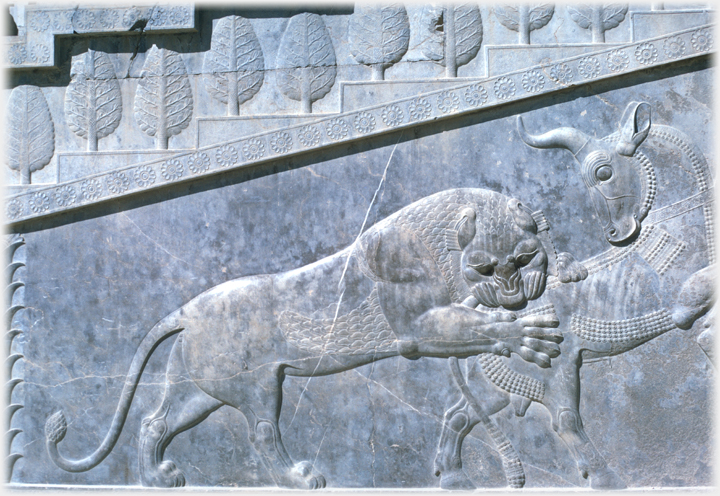

Beautiful Amorality
...there is the possibility of beauty here, a beauty inexhaustible in its complexity, which opens to my knock, which answers in me a call I do not remember calling ... life itself is so astonishingly cheap, that nature is as careless as it is bountiful, and that with extravagance goes a crushing waste that will one day include our own cheap lives....there is no right and wrong in nature; right and wrong is a human concept. Precisely: we are moral creatures, then, in an amoral world. ...Although it is true that we are moral creature in an amoral world, the world’s amorality does not make it a monster.
Annie Dillard (1974)

There is nothing new in noticing amorality in nature, as this 2,500 year old Persepolis relief shows. From ants to lions we have long watched, often with misgivings, the way animals (and indeed plants) treat animals. What seems refreshing in Dillard’s writing is forcing that amorality to confront the beauty that humans so often also find in nature. She returns to this perceived
paradox
 We have a distaste for contradictions which are however ubiquitous.
repeatedly, approaching it from diverse angles; nagging, cajoling, challenging our conceptions of the world we find ourselves in, a world which is utterly without regard to its individuals and their lives, and yet is profoundly beautiful, ridiculously prolific, and of a subtlety, delicacy, intricacy and splendour that constantly brings us to a halt with its
spectacles.
We have a distaste for contradictions which are however ubiquitous.
repeatedly, approaching it from diverse angles; nagging, cajoling, challenging our conceptions of the world we find ourselves in, a world which is utterly without regard to its individuals and their lives, and yet is profoundly beautiful, ridiculously prolific, and of a subtlety, delicacy, intricacy and splendour that constantly brings us to a halt with its
spectacles.
 On the way we are arrested by wonder.
On the way we are arrested by wonder.
Repeatedly, from Plato’s time, writers have stressed the apparent consonance between
aesthetics
 A little on the aesthetic side of that elision.
and ethics: between beauty and what is good. Now Dillard wants us to stand with her in seeing the unity of
wonder
A little on the aesthetic side of that elision.
and ethics: between beauty and what is good. Now Dillard wants us to stand with her in seeing the unity of
wonder
 Wonder as a fundamental power both within us and beyond.
and horror in nature.
Wonder as a fundamental power both within us and beyond.
and horror in nature.
The Dillard book Pilgrim at Tinker Creekwas originally published in Harper’s Magazine. The quote takes passages from three places, viz pages 141, 179, and 181 of the 2022 Canterbury Press Edition.
The photo is of one of the panels on the great staircase of Persepolis in southern Iran.
Above, hovering on blue introduces a link: click to go, move away to stay.

Saturday 25th October 2025
 ...guide to this site
...guide to this site